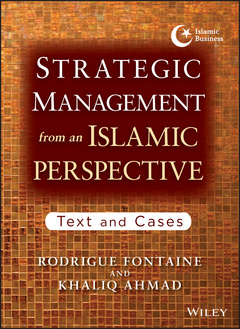Foreword xiii Preface xv Acknowledgments xvii Part I Strategy: An Islamic Perspective 1 1 Introduction 3 Leading an Organization Is Like Driving a Car 4 Critical Thinking 5 The Problem with Conventional Management 6 The Problem with Conventional Strategic Management 7 The Value of Strategic Management from an Islamic Perspective 9 References 11 Notes 12 2 Conventional Strategic Management 13 Introduction 13 The Importance of Competitive Advantage 13 Competitive Advantage: A Means or an End? 15 The Importance of Stakeholders 16 The Strategic Management Process 17 Strategic Management in Developing Countries 19 Why Do Most Strategies Fail? 20 First Observation: Causal Ambiguity 24 Second Observation: Strategic Thinking 24 Third Observation: Profitability versus Risk 27 Summary 28 References 28 Notes 30 3 Four Fundamental Problems 31 Introduction 31 FP 1: The Use of Interest–Based Loans 31 FP 2: Developing Sustainable Organizations 35 FP 3: Overcoming Defensive Routines 43 FP 4: Overcoming Conflicts of Interest 45 Discussion 49 Summary 51 References 52 Notes 54 4 Organizational Justice 55 Introduction 55 Elements in Organizational Justice 56 Hammer and Champy 60 W. Edwards Deming 62 Eli Goldratt 64 Discussion 66 Summary 70 References 70 Notes 72 5 Islam Transforms People and Leaders 73 Introduction 73 The Individual as the Unit of Analysis 74 Belief in Islam Appeals to the Intellect 80 Islam in the Context of an Organization 82 Islam in the Context of Multicultural Societies 83 The Importance of Prayer 90 The PIES Model 91 The Driving Analogy 91 Summary 92 References 92 Notes 94 6 The Challenge of Culture 95 Introduction 95 The Link between Culture and Strategy 96 Lessons from Research at the International Islamic University Malaysia 97 The Role of Top Management 101 Summary 106 References 107 Note 108 7 The Role of Islamic Law 109 Introduction 109 Why Do We Need Islamic Law? 109 Principles of Islamic Law 111 The Importance of Intention and Knowledge 113 Islamic Law for Top Management 114 Islamic Law for Middle Management 115 Islamic Law for Subordinates 116 Shariah and Fiqh 117 The Need for Further Research 118 Summary 119 References 119 Notes 120 8 Strategic Decision Making 121 Introduction 121 A Broader View of Strategy 124 Strategy as Problem Solving 125 Errors in Strategic Decision Making 126 Defining the Strategic Problem 127 Understanding the Strategic Problem 128 Experimenting 131 Strategic Decision Making 132 Evaluating the Strategic Process 134 Summary 135 References 137 Notes 139 9 Analyzing a Case 141 The Purpose of Analyzing a Case 141 Choosing the Story 148 Part II Case Studies 151 Cases in This Textbook 151 Note 154 10 Case 1: IBM and Lou Gerstner 155 Introduction 155 The Beginning 155 The Writing on the Wall 156 Finding a New CEO 157 The First Days at IBM 157 The Corporate Culture Problem 159 Do We Need a Strategic Vision? 160 Getting the Execution Right 161 The Essence of Leadership 161 Reviving the Brand 162 Compensation 162 Making the Company Grow Again 163 References 164 11 Case 2: Al Rajhi Bank 165 The Job Offer 165 Al Rajhi&rsquo,s Background 166 Bilal&rsquo,s Conclusions 172 12 Case 3: Bank Muamalat 173 Zabeda&rsquo,s Report 173 The Beginning of Bank Muamalat 173 Top Management Structure 174 The Financial Performance 175 Putting IT to Work 176 The Competitive Environment 177 Zabeda&rsquo,s Supervisor&rsquo,s Comments 179 References 180 13 Case 4: Bank Rakyat 181 The Strategic Challenge 181 The Cooperative Movement 181 Bank Rakyat 182 Marketing at Bank Rakyat 183 Putting IT to Work 184 Future Plans 185 References 185 Note 186 14 Case 5: MUSLEH (Part 1) 187 The Dilemma 187 MUSLEH 187 The Founding of MUSLEH 188 The Personality of Ustaz Amin 189 The Classical Strategic Management Framework 189 Connections with Other Professionals 191 Setting a New Direction for the Group 192 Note 192 15 Case 6: MUSLEH (Part 2) 193 Introduction 193 Changes in the Middle East 193 Dr. Tareq Al Suwaidan 194 Dr. Amr Khaled 196 The Debate 196 A Trip to Kuwait City 197 What to Do Next? 198 16 Case 7: Fuji Xerox 201 The Phone Call 201 An Overview of Fuji Xerox 202 Fuji&rsquo,s Emphasis on CSR and Sustainability 202 Fuji&rsquo,s Marketing Initiatives 205 A SWOT Analysis of Fuji Strategy 206 An Analysis of Fuji&rsquo,s Financial Results 207 Conclusion 208 17 Case 8: McDonald&rsquo,s Pakistan 209 The Dilemma 209 The Company Profile 210 Raza Ali 211 Rashid Ibrahim 211 McCafé, 212 McDonald&rsquo,s Target Market 213 The Main Competitor: Gloria Jean&rsquo,s Coffees 213 Back to the Dilemma 214 18 Case 9: Unilever Bangladesh 215 The Appointment 215 Bangladesh 215 Industry Factors 216 Industry Players 217 The Organization&rsquo,s Structure 220 Financial Management 221 Marketing Management 221 UBL Products 222 Brand Promotion 222 Pricing 223 Operations Management 223 Human Resources Management 223 Conculsion 224 Notes 224 Appendix: A Primer on Evolution 225 About the Authors 231 About the Contributors 233 Index 235





